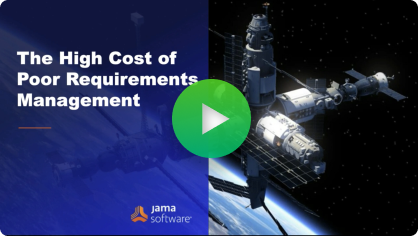Requirements Engineering
The Essential Guide to Requirements Management and Traceability
Chapters
- 1. Requirements Management
- Overview
- 1 What is Requirements Management?
- 2 Why do you need Requirements Management?
- 3 Four Stages of Requirements Management Processes
- 4 Adopting an Agile Approach to Requirements Management
- 5 Status Request Changes
- 6 Conquering the 5 Biggest Challenges of Requirements Management
- 7 Three Reasons You Need a Requirements Management Solution
- 8 Guide to Poor Requirements: Identify Causes, Repercussions, and How to Fix Them
- 2. Writing Requirements
- Overview
- 1 Functional requirements examples and templates
- 2 Identifying and Measuring Requirements Quality
- 3 How to write system requirement specification (SRS) documents
- 4 The Fundamentals of Business Requirements: Examples of Business Requirements and the Importance of Excellence
- 5 Adopting the EARS Notation to Improve Requirements Engineering
- 6 Jama Connect Advisor™
- 7 Frequently Asked Questions about the EARS Notation and Jama Connect Advisor™
- 8 How to Write an Effective Product Requirements Document (PRD)
- 9 Functional vs. Non-Functional Requirements
- 10 What Are Nonfunctional Requirements and How Do They Impact Product Development?
- 11 Characteristics of Effective Software Requirements and Software Requirements Specifications (SRS)
- 12 8 Do’s and Don’ts for Writing Requirements
- 3. Requirements Gathering and Management Processes
- Overview
- 1 Requirements Engineering
- 2 Requirements Analysis
- 3 A Guide to Requirements Elicitation for Product Teams
- 4 Requirements Gathering Techniques for Agile Product Teams
- 5 What is Requirements Gathering?
- 6 Defining and Implementing a Requirements Baseline
- 7 Managing Project Scope — Why It Matters and Best Practices
- 8 How Long Do Requirements Take?
- 9 How to Reuse Requirements Across Multiple Products
- 4. Requirements Traceability
- Overview
- 1 What is Requirements Traceability? Importance Explained
- 2 How is Traceability Achieved? A Practical Guide for Engineers
- 3 Tracing Your Way to Success: The Crucial Role of Traceability in Modern Product and Systems Development
- 4 Change Impact Analysis (CIA): A Short Guide for Effective Implementation
- 5 What is Requirements Traceability and Why Does It Matter for Product Teams?
- 6 What is Meant by Version Control?
- 7 Key Traceability Challenges and Tips for Ensuring Accountability and Efficiency
- 8 Unraveling the Digital Thread: Enhancing Connectivity and Efficiency
- 9 The Role of a Data Thread in Product and Software Development
- 10 How to Create and Use a Requirements Traceability Matrix
- 11 Traceability Matrix 101: Why It’s Not the Ultimate Solution for Managing Requirements
- 12 Live Traceability vs. After-the-Fact Traceability
- 13 How to Overcome Organizational Barriers to Live Requirements Traceability
- 14 Requirements Traceability, What Are You Missing?
- 15 Four Best Practices for Requirements Traceability
- 16 Requirements Traceability: Links in the Chain
- 17 What Are the Benefits of End-to-End Traceability During Product Development?
- 5. Requirements Management Tools and Software
- Overview
- 1 Selecting the Right Requirements Management Tools and Software
- 2 Why Investing in Requirements Management Software Makes Business Sense During an Economic Downturn
- 3 Why Word and Excel Alone is Not Enough for Product, Software, and Systems Development
- 4 Application lifecycle management (ALM)
- 5 Is There Life After DOORS®?
- 6 Can You Track Requirements in Jira?
- 7 Checklist: Selecting a Requirements Management Tool
- 6. Requirements Validation and Verification
- 7. Meeting Regulatory Compliance and Industry Standards
- Overview
- 1 Understanding ISO Standards
- 2 Understanding ISO/IEC 27001: A Guide to Information Security Management
- 3 What is DevSecOps? A Guide to Building Secure Software
- 4 Compliance Management
- 5 What is FMEA? Failure Modes and Effects Analysis
- 6 TÜV SÜD: Ensuring Safety, Quality, and Sustainability Worldwide
- 8. Systems Engineering
- Overview
- 1 What is Systems Engineering?
- 2 How Do Engineers Collaborate? A Guide to Streamlined Teamwork and Innovation
- 3 The Systems Engineering Body of Knowledge (SEBoK)
- 4 What is MBSE? Model-Based Systems Engineering Explained
- 5 Digital Engineering Between Government and Contractors
- 6 Digital Engineering Tools: The Key to Driving Innovation and Efficiency in Complex Systems
- 9. Automotive Development
- 10. Medical Device & Life Sciences Development
- Overview
- 1 The Importance of Benefit-Risk Analysis in Medical Device Development
- 2 Software as a Medical Device: Revolutionizing Healthcare
- 3 What’s a Design History File, and How Are DHFs Used by Product Teams?
- 4 Navigating the Risks of Software of Unknown Pedigree (SOUP) in the Medical Device & Life Sciences Industry
- 5 What is ISO 13485? Your Comprehensive Guide to Compliant Medical Device Manufacturing
- 6 What You Need to Know: ANSI/AAMI SW96:2023 — Medical Device Security
- 7 ISO 13485 vs ISO 9001: Understanding the Differences and Synergies
- 8 Failure Modes, Effects, and Diagnostic Analysis (FMEDA) for Medical Devices: What You Need to Know
- 9 Embracing the Future of Healthcare: Exploring the Internet of Medical Things (IoMT)
- 11. Aerospace & Defense Development
- 12. Architecture, Engineering, and Construction (AEC industry) Development
- 13. Industrial Manufacturing & Machinery, Automation & Robotics, Consumer Electronics, and Energy
- 14. Semiconductor Development
- 15. AI in Product Development
- Glossary
Chapter 3: Requirements Engineering
Chapters
- 1. Requirements Management
- Overview
- 1 What is Requirements Management?
- 2 Why do you need Requirements Management?
- 3 Four Stages of Requirements Management Processes
- 4 Adopting an Agile Approach to Requirements Management
- 5 Status Request Changes
- 6 Conquering the 5 Biggest Challenges of Requirements Management
- 7 Three Reasons You Need a Requirements Management Solution
- 8 Guide to Poor Requirements: Identify Causes, Repercussions, and How to Fix Them
- 2. Writing Requirements
- Overview
- 1 Functional requirements examples and templates
- 2 Identifying and Measuring Requirements Quality
- 3 How to write system requirement specification (SRS) documents
- 4 The Fundamentals of Business Requirements: Examples of Business Requirements and the Importance of Excellence
- 5 Adopting the EARS Notation to Improve Requirements Engineering
- 6 Jama Connect Advisor™
- 7 Frequently Asked Questions about the EARS Notation and Jama Connect Advisor™
- 8 How to Write an Effective Product Requirements Document (PRD)
- 9 Functional vs. Non-Functional Requirements
- 10 What Are Nonfunctional Requirements and How Do They Impact Product Development?
- 11 Characteristics of Effective Software Requirements and Software Requirements Specifications (SRS)
- 12 8 Do’s and Don’ts for Writing Requirements
- 3. Requirements Gathering and Management Processes
- Overview
- 1 Requirements Engineering
- 2 Requirements Analysis
- 3 A Guide to Requirements Elicitation for Product Teams
- 4 Requirements Gathering Techniques for Agile Product Teams
- 5 What is Requirements Gathering?
- 6 Defining and Implementing a Requirements Baseline
- 7 Managing Project Scope — Why It Matters and Best Practices
- 8 How Long Do Requirements Take?
- 9 How to Reuse Requirements Across Multiple Products
- 4. Requirements Traceability
- Overview
- 1 What is Requirements Traceability? Importance Explained
- 2 How is Traceability Achieved? A Practical Guide for Engineers
- 3 Tracing Your Way to Success: The Crucial Role of Traceability in Modern Product and Systems Development
- 4 Change Impact Analysis (CIA): A Short Guide for Effective Implementation
- 5 What is Requirements Traceability and Why Does It Matter for Product Teams?
- 6 What is Meant by Version Control?
- 7 Key Traceability Challenges and Tips for Ensuring Accountability and Efficiency
- 8 Unraveling the Digital Thread: Enhancing Connectivity and Efficiency
- 9 The Role of a Data Thread in Product and Software Development
- 10 How to Create and Use a Requirements Traceability Matrix
- 11 Traceability Matrix 101: Why It’s Not the Ultimate Solution for Managing Requirements
- 12 Live Traceability vs. After-the-Fact Traceability
- 13 How to Overcome Organizational Barriers to Live Requirements Traceability
- 14 Requirements Traceability, What Are You Missing?
- 15 Four Best Practices for Requirements Traceability
- 16 Requirements Traceability: Links in the Chain
- 17 What Are the Benefits of End-to-End Traceability During Product Development?
- 5. Requirements Management Tools and Software
- Overview
- 1 Selecting the Right Requirements Management Tools and Software
- 2 Why Investing in Requirements Management Software Makes Business Sense During an Economic Downturn
- 3 Why Word and Excel Alone is Not Enough for Product, Software, and Systems Development
- 4 Application lifecycle management (ALM)
- 5 Is There Life After DOORS®?
- 6 Can You Track Requirements in Jira?
- 7 Checklist: Selecting a Requirements Management Tool
- 6. Requirements Validation and Verification
- 7. Meeting Regulatory Compliance and Industry Standards
- Overview
- 1 Understanding ISO Standards
- 2 Understanding ISO/IEC 27001: A Guide to Information Security Management
- 3 What is DevSecOps? A Guide to Building Secure Software
- 4 Compliance Management
- 5 What is FMEA? Failure Modes and Effects Analysis
- 6 TÜV SÜD: Ensuring Safety, Quality, and Sustainability Worldwide
- 8. Systems Engineering
- Overview
- 1 What is Systems Engineering?
- 2 How Do Engineers Collaborate? A Guide to Streamlined Teamwork and Innovation
- 3 The Systems Engineering Body of Knowledge (SEBoK)
- 4 What is MBSE? Model-Based Systems Engineering Explained
- 5 Digital Engineering Between Government and Contractors
- 6 Digital Engineering Tools: The Key to Driving Innovation and Efficiency in Complex Systems
- 9. Automotive Development
- 10. Medical Device & Life Sciences Development
- Overview
- 1 The Importance of Benefit-Risk Analysis in Medical Device Development
- 2 Software as a Medical Device: Revolutionizing Healthcare
- 3 What’s a Design History File, and How Are DHFs Used by Product Teams?
- 4 Navigating the Risks of Software of Unknown Pedigree (SOUP) in the Medical Device & Life Sciences Industry
- 5 What is ISO 13485? Your Comprehensive Guide to Compliant Medical Device Manufacturing
- 6 What You Need to Know: ANSI/AAMI SW96:2023 — Medical Device Security
- 7 ISO 13485 vs ISO 9001: Understanding the Differences and Synergies
- 8 Failure Modes, Effects, and Diagnostic Analysis (FMEDA) for Medical Devices: What You Need to Know
- 9 Embracing the Future of Healthcare: Exploring the Internet of Medical Things (IoMT)
- 11. Aerospace & Defense Development
- 12. Architecture, Engineering, and Construction (AEC industry) Development
- 13. Industrial Manufacturing & Machinery, Automation & Robotics, Consumer Electronics, and Energy
- 14. Semiconductor Development
- 15. AI in Product Development
- Glossary
What is Requirements Engineering? An Overview and Intro into Requirements Engineering
Requirements management (RM) is a challenge for many companies, partly due to the ambiguity involved in software development. First, you must understand the client’s requirements. Second, you must match those requirements to critical processes.
RM is a component of requirements engineering (RE), which bridges the divide between a client’s needs and what developers create. When done well, RE has the ability to create a solid framework for software development. This is critical since poor software engineering requirements management is a root of many project failures.
A CIO magazine study found that “Analysts report that as many as 71% of software projects that fail do so because of poor requirements management, making it the single biggest reason for project failure.”
In 1999, NASA built the $125 million Mars Climate Orbiter probe. The probe failed because it entered orbit 100 kilometers too close to Mars. The source of the error was a conflict between different requirements; eliminating such conflicts is an important component of RE.
Understanding the details involved in requirements engineering and best practices can set you on the path to successfully meeting client expectations.
What is requirements engineering?
Clients have a long list of goals when creating new software, and RE provides a framework for meeting those goals. Important needs are inventoried and transformed into a detailed set of requirements. Requirements development dictates future development activities and creates a blueprint for success.
The terms “requirements management” and “requirements engineering” are often used interchangeably, but they are different. RM is one piece of requirements engineering, and getting it right makes all the difference.
RE ensures that the problem a client wants solved is clearly defined and the solution is both accurate and effective. Essentially, RE transforms a real-world problem into a highly functional software solution.
The 4 steps of the requirements engineering process
The requirements engineering process has many potential pitfalls. Strengthening your RE process enables you to avoid many common challenges. The process serves as a compass, guiding you in determining the exact deliverables and doing so with greater accuracy. All important parties are on the same page about what steps need to be taken to achieve the desired outcome. Strengthen your RE process by considering the following:
Elicit requirements. Elicitation is about becoming familiar with all the important details involved with the project. The customer will provide details about their needs and furnish critical background information. You will study those details and also become familiar with similar types of software solutions. This step provides important context for development.
Requirements specification. During the specification phase, you gather functional and nonfunctional project requirements. A variety of tools are used during this stage, including data flow diagrams, to add more clarity to the project goals.
Verification and validation. Verification ensures the software is built to the customer’s requirements. In contrast, validation ensures the software is implementing the right functions. If the requirements don’t go through the validation stage, there is the potential for time-consuming and expensive reworks.
Requirements management. RM is an ongoing process that runs in parallel to the other three processes just described. In RM, you’re matching all the relevant processes to their requirements. You will analyze, document, and prioritize the requirements – and communicate with relevant stakeholders. Any requirements that need modification are handled in an efficient and systematic manner.
As you implement the different components of RE, it also helps you get a sense of what should be excluded from requirements. Understanding this will help you focus more accurately on developing requirements and better meeting client expectations.
What information should be excluded from the requirements?
Requirements should be viewed as addressing a problem but not necessarily as providing a solution. A requirement should clearly state what you want to solve, not how you want to solve it. Let’s take a look at guidelines for good requirements:
- The requirement accurately defines the need of the stakeholder.
- The requirement is testable.
A requirement needs to be clear and understandable, without the risk of ambiguity. An important step in developing good requirements is the review process. Does the requirement accurately express the needs of the stakeholders? Make sure to build in enough client reviews so that you can get early feedback and adjust as needed.
Common mistakes to avoid
There are many challenges that may occur as you develop your RE framework. Understanding potential issues can help you avoid them. Consider the following as you develop your processes:
- Avoid scope creep. There is a temptation to add “just one tiny new requirement” to make the client happy. But these little changes add up and may have an impact on future activities, such as testing, documentation and more.
- Resist the urge to “over-engineer.” Over-engineering can be tempting, especially when you want to make sure everything is just right for the client. But this overzealousness can backfire. Adding a little extra code because “I’m doing this, I may as well do that” might seem logical, these changes can create a ripple effect, putting requirements at risk in the future.
- Not building in enough feedback and reviews. Early feedback is essential to a project’s success. Build in frequent reviews and solid traceability to get feedback often and early.
- Failing to search thoroughly for all the important stakeholders. You might think you’ve included all the important stakeholders, only to learn you missed one later on. Invest time early in the process to find any and all important stakeholders in order to avoid expensive reworks later in the process.
- Failing to identify potential resistance early in the process. Resistance can be an invisible but serious project problem. Learn to identify resistance early in the process so that you can work through it efficiently and early, getting everyone on the same page.
Awareness of these potential pitfalls can save you time, money and resources during the RE process. Also, look at your existing processes and whether they include enough traceability. Ensuring that deliverables meet requirements, for example, is much easier if every requirement is linked to at least one test. Traceability is an essential part of this process.
Engineers can then invest their energy into requirements that are failing the test and get the project back on track quickly.
Leveraging the right tools for success
Requirements engineering is critical to the success of a project because it tells everyone involved with the project what needs to be done. The more accurate the requirements, the easier it is for the project manager to schedule development tasks, for example. A requirements management software tool can greatly support successful RE, as it enables more efficient and optimized product and system development.
This type of tool can provide:
- Clarity and visibility. Gain broader visibility into what you’re building and why.
- Live traceability. Ensure product quality and improve change management with complete traceability.
- Decision tracking and fast reviews. Conduct virtual reviews of requirements, test cases, user needs and more.
- Real-time collaboration. Immediately note and prioritize important decisions, pull in the required stakeholders and reference historical context to eliminate communication errors.
The right tool can help you transform RM as you easily track, review, sign-off and truly understand how and why you did certain things. As a result, you can streamline your product development process and increase efficiency, understand and respond to change, and establish a higher level of clarity and visibility.
See how Jama Connect can help with requirements engineering by downloading our solution overview.
RELATED ARTICLE: Best Practices Guide to Requirements & Requirements Management
Learn More About the Impact of Poor Requirements Management
Requirements Engineering ensures that the problem a client wants solved is clearly defined and the solution is both accurate and effective. Essentially, RE transforms a real-world problem into a clear specification for a highly functional solution.
Book a Demo
See Jama Connect in Action!
Our Jama Connect experts are ready to guide you through a personalized demo, answer your questions, and show you how Jama Connect can help you identify risks, improve cross-team collaboration, and drive faster time to market.



